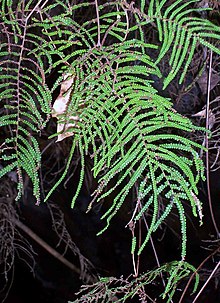 |
| Steve Hasiotis. fossil termite mound |
And it was a fortuitous chain of events that led me down the rabbit hole of knowledge towards the subject of today's blog post. Inspired by the interesting paper documenting in situ vegetation recorded at Big Cedar Ridge Wyoming from the late Cretaceous (discussed in Plant Wars) and the mention of the unique fern peatlands deposited there I decided to look more into peatlands. I was a little surprised that, in addition to the classic 'moor' type peatlands dominated by spagnhum moss found in high latitudes, southeast Asia contains some of the most extensive peatlands in the world. Of course the peat lowland forests of Borneo and Indonesia differ form your classic moor type peatlands in many ways- most notably in significant tree cover- but they are similar in that they are poor nutrient habitats due to lack of sediment input and that the decay of vegetation moves very slowly due to anoxic conditions. Peatlands therefore serve as tremendous carbon sinks. Although slash and burn agriculture in tropical forests has received loads of attention as an input for global warming, what has received scant attention is the draining and burning of peatlands in southeast Asia. Like a slow burning ember burning peat can remain fairly cryptic and go unnoticed but then suddenly erupt in flames after travelling long distances underground.
Now this is all fine and dandy and maybe a little eye-opening but the idea of tropical peat-swamp forests was very interesting to me. This revelation coupled with proof of peat-type deposits from Cretaceous times got me thinking: how important were these fern peatlands during the Mesozoic?
A little internet sleuthing revealed an interesting little paper from Russia written during the end of the Cold War: Changes of Mesozoic Vegetation and the Extinction of Dinosaurs by V.A. Krassilov. Although there is plenty wrong with the paper, Krassilov does in fact speculate that fern swamps/peat lands were important habitats for many herbivorous dinosaurs- bursting my bubble and beating me to the punch by about 33 years. Anyways, its quite a gem of a paper- very speculative but very interesting check it out. It does seem sometimes, as novel an idea you think you might have, someone else likely thought of it in the (distant) past.
The next paper I came upon looking for info on Mesozoic peatlands was this little ditty documenting warm/humid lacustrine habitat from the Late Jurassic near Cation City Colorado. The authors argue for a fairly humidclimate /high water table in this site due to the high diversity of ferns, Czekanowskia plants, and other water lovers. The ferns recovered most likely represent types of the genus Gleichenia, extant members are known for thriving in moisture heavy, nutrient poor soils.
 |
| Gleichenia dicarpa. Corral fern |
So is this Temple Canyon flora evidence of another fern peatland? Did vast herds of dinosaurs exploit some type of distinctly Mesozoic fern swamp/peatland? Granted the Mesozoic was a looooooonnnng time and it is hard to generalize such an era- but fern dominated swamp-lands do make a lot of sense as potential critical habitats for large herbivorous dinos. Certainly the low continental relief/epicontinental seas and balmy weather provided an ideal congruence of conditions where it is easy to imagine such vast fern peatlands.... hopefully more data will come to light and/or additional in situ flora sites preserved.
But I am not done yet with this voyage of discovery. In the above Temple Canyon paper there was a brief mention of something pretty darn interesting: "Elsewhere, the mid-Morrison unconformity is also associated with abundant ichnofossils, particularly giant termite nests (e.g. Hasiotis, 2004)."
Now I had long heard mention of the termites of the Morrison formation and I remember reading a Wiki entry on the Morrison which mentions termite nests of 30 meters (100 ft)! But I had always assumed that this was a typo...surely 100 foot tall termite nests were not possible...or are they? Does that measurement of 30 meters imply that the nest was above ground, or could the vast majority of it be underground? If these massive nests existed might termites, as opposed to sauropods, have been the true ecological movers and shakers in the Morrison- or possibly even much of the Mesozoic?
More to come as I delve deeper into the mystery of ancient termites....
Cheers!
Support me on Patreon.
Like antediluvian salad on facebook.
Watch me on Deviantart @NashD1.Subscribe to my youtube channel Duane Nash.
My other blog southlandbeaver.blogspot.

2 comments:
I'd just like to point out that lots of termites at the end of the Cretaceous doesn't necessarily translate into termite domination throughout the Mesozoic. The documented dearth of small-bodied animals in the Jurassic suggests, rather, that sauropods may have outcompeted insects back then.
I agree with the first sentence- its definitely over reaching to suggest this dominance in all habitats, just as it is so today. But a growing body of evidence is suggesting that social insects were established a lot sooner than previously thought. Since termites inhabit well drained soils and of course are soft bodied its easy to surmise there is a bit of fossilization bias against them. As far as a "documented death of small bodied animals in the Jurassic " I believe a lot of this has to do with fossil bias as well. When we do get good microfossil sites the small critters are there- we just need more data. The sauropod vs termite competition is a bit of red herring I put forth. In reality I believe herbivorous dinos and insects/snails/other inverts were more complimentary in their ecological relationships. Dinos would have munched a lot of the new growth, perhaps a majority of it. Inverts, especially termites (descended from roach type bugs) were prime decomposers- and a prized meal would have been giant dino feces. Hatchling dinos in turn, even purported "herbivores", would have enjoyed insect snacks as well. Circle of life.
Post a Comment